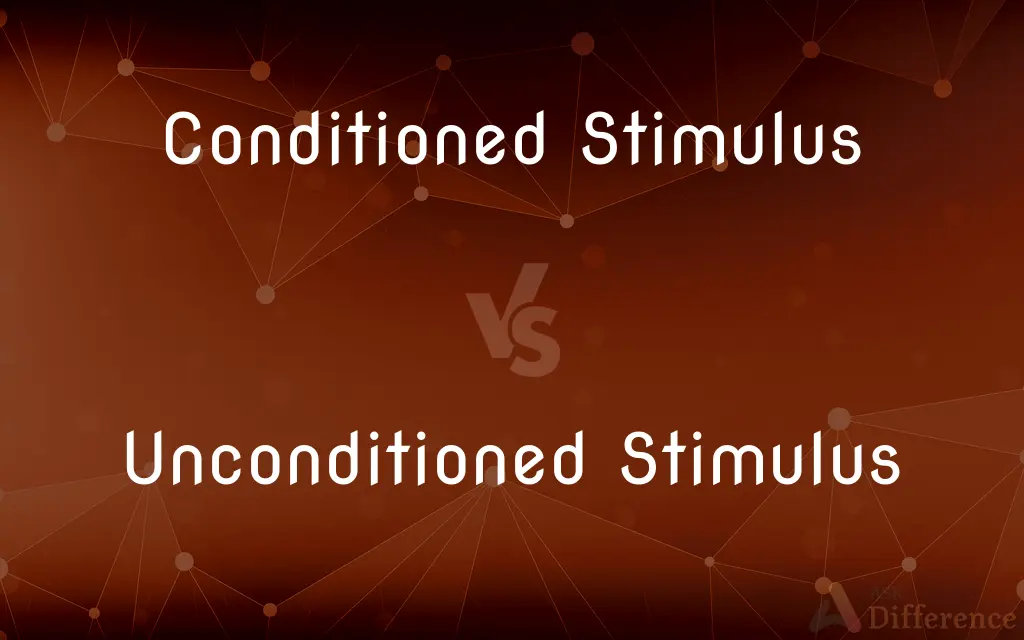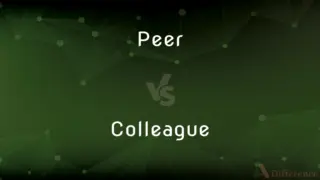Conditioned Stimulus vs. Unconditioned Stimulus — What's the Difference?
By Tayyaba Rehman — Published on November 7, 2023
Conditioned Stimulus previously neutral stimulus that, after association, triggers a conditioned response. Unconditioned Stimulus naturally triggers a reflexive response without needing learning.

Difference Between Conditioned Stimulus and Unconditioned Stimulus
Table of Contents
ADVERTISEMENT
Key Differences
Conditioned Stimulus involves a learning process where a previously neutral stimulus comes to evoke a response through association with another stimulus. Unconditioned Stimulus, on the other hand, naturally and automatically triggers a reflexive response, with no learning or conditioning necessary. These two terms represent different ends of the learning and response spectrum, forming the core of classical conditioning.
In an experiment involving Conditioned Stimulus, a neutral stimulus, like a bell ring, may be paired with an Unconditioned Stimulus, such as food, to eventually trigger a similar response. Unconditioned Stimulus relies on innate, automatic reactions, as certain stimuli naturally induce specific responses, such as salivating in response to smelling food. The involvement and necessity of learning differentiate these two stimuli in psychological studies.
The Conditioned Stimulus becomes associated with a particular outcome through repetitive pairing and learning. The Unconditioned Stimulus does not require repetitive pairing to produce a response since it naturally induces reactions. Through understanding these different stimuli, psychologists can explore and explain learned and reflexive behaviors in various organisms.
Over time, a Conditioned Stimulus can lose its effectiveness in eliciting a response if the association with the unconditioned stimulus is broken, through a process known as extinction. In contrast, an Unconditioned Stimulus consistently elicits a response because it doesn’t rely on learned associations. Thus, while one can be affected by discontinuation, the other remains persistently effective.
Comparison Chart
Learning Requirement
Requires learning through association.
Does not require learning; naturally triggers a response.
ADVERTISEMENT
Example
Bell ring (after conditioning).
Food smell.
Response Type
Triggers a learned response.
Triggers a natural, reflexive response.
Involvement in Experiment
Used to create a new association/response.
Used to naturally evoke a response.
Effectiveness Over Time
May lose effectiveness (extinction).
Consistently effective.
Compare with Definitions
Conditioned Stimulus
May lose effectiveness in eliciting a response if not reinforced.
Without reinforcement, the bell as a Conditioned Stimulus ceased to cause salivation.
Unconditioned Stimulus
Does not require learning or conditioning to provoke a response.
The painful shock, an Unconditioned Stimulus, caused an immediate withdrawal response.
Conditioned Stimulus
Capable of triggering a conditioned response after successful pairing.
The Conditioned Stimulus of a tone led to the rat pressing the lever.
Unconditioned Stimulus
Consistently effective in eliciting a particular response.
Every time the Unconditioned Stimulus of a puff of air hit the eye, blinking occurred.
Conditioned Stimulus
Utilized in psychological experiments to explore learned behavior.
Scientists used a light as a Conditioned Stimulus to study associative learning in birds.
Unconditioned Stimulus
Automatically and naturally triggers a reflexive response.
The Unconditioned Stimulus of food smell made the dog salivate.
Conditioned Stimulus
A stimulus that requires associative learning to provoke a response.
The dog salivated at the Conditioned Stimulus of a bell after learning it meant food.
Unconditioned Stimulus
Used in conditioning to pair with a neutral stimulus.
The Unconditioned Stimulus of food was paired with a bell to study classical conditioning.
Conditioned Stimulus
Initially neutral until paired with an unconditioned stimulus to gain significance.
The light became a Conditioned Stimulus after pairing with food delivery.
Unconditioned Stimulus
Reliably elicits an unconditioned response.
The meat powder, an Unconditioned Stimulus, always caused the dog to salivate.
Common Curiosities
Can you give an example of both?
In Pavlov's dog experiment, the unconditioned stimulus is food, and the conditioned stimulus is the sound of a bell after conditioning.
What is an Unconditioned Response (UR)?
It is the natural and automatic response to the unconditioned stimulus, like salivating in response to food.
What is a Conditioned Response (CR)?
It is the learned response to the conditioned stimulus, like salivating in response to the sound of a bell after conditioning.
What is an Unconditioned Stimulus (US)?
An unconditioned stimulus is something that naturally and automatically triggers a response without previous conditioning.
What is a Conditioned Stimulus (CS)?
A conditioned stimulus is a previously neutral stimulus that, after being associated with the unconditioned stimulus, eventually triggers a conditioned response.
Can a conditioned response be unlearned?
Yes, through processes like extinction, where the CS is presented repeatedly without the US, weakening the association.
How long does it take for conditioning to occur?
It varies. Some pairings may take only one or a few associations, while others might take many repetitions.
Does conditioning work with all stimuli and responses?
Not always. Some pairings are more naturally fitting than others, and not all responses can be conditioned.
Is the strength of the US important in conditioning?
Yes, a more potent US will typically lead to faster and more robust conditioning.
How are CS and US related in classical conditioning?
Through repeated pairing, a neutral stimulus (which becomes the CS) is associated with the US, leading to the conditioned response.
What's "higher-order conditioning"?
It's when a conditioned stimulus is paired with a new, neutral stimulus, creating a second conditioned stimulus.
Is classical conditioning limited to laboratory settings?
No, it occurs in real-world situations all the time, like when a song reminds you of a past event.
How is a CS different from the US?
CS is a learned trigger for a response, while US is a natural trigger for a response.
Can humans be subjects of classical conditioning?
Yes, humans can be conditioned just like any other animal.
Can there be multiple CS for a single UR or CR?
Yes, through processes like generalization, where stimuli similar to the CS also trigger the conditioned response.
Share Your Discovery

Previous Comparison
Myelinated Axons vs. Unmyelinated Axons
Next Comparison
Hunan Chicken vs. Szechuan ChickenAuthor Spotlight
Written by
Tayyaba RehmanTayyaba Rehman is a distinguished writer, currently serving as a primary contributor to askdifference.com. As a researcher in semantics and etymology, Tayyaba's passion for the complexity of languages and their distinctions has found a perfect home on the platform. Tayyaba delves into the intricacies of language, distinguishing between commonly confused words and phrases, thereby providing clarity for readers worldwide.
















































